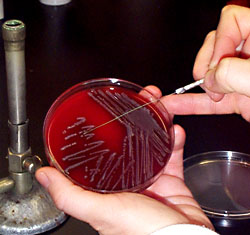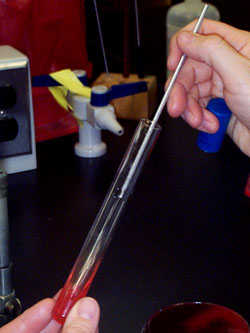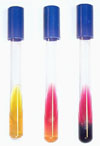Introduction
Principles/Images
Protocol
Recipe
Comments/Safety
Contributions
Microbe Library
|
Protocol
Use a straight inoculating needle to pickup an isolated colony.
Images © Don Lehman
|
 |
| Inoculate the TSI slant by first stabbing the butt down to the bottom, withdraw the needle, and then streak the surface of the slant. Use a loosely fitting closure to permit access of air. |
 |
Read results after incubation at 37°C for 18 to 24 h. Three kinds of data may be obtained from the reactions.
Sugar fermentations
-
Acid butt, alkaline slant (yellow butt, red slant): glucose has been fermented but not sucrose or lactose.
-
Acid butt, acid slant (yellow butt, yellow slant): lactose and/or sucrose has been fermented.
- Alkaline butt, alkaline slant (red butt, red slant): neither glucose, lactose, nor sucrose has been fermented.
Gas production
- Indicated by bubbles in the butt. With large amounts of gas, the agar may be broken or pushed upward.
Hydrogen sulfide production
- Hydrogen sulfide production from thiosulfate is indicated by a blackening of the butt as a result of the reaction of H2S with the ferrous ammonium sulfate to form black ferrous sulfide.
Reference: Gephart, P., R.G. E. Murray, W.A. Wood, and N.R. Krieg. (1994) Methods for General and Molecular Bacteriology, ASM Press, Washington. DC.
|

